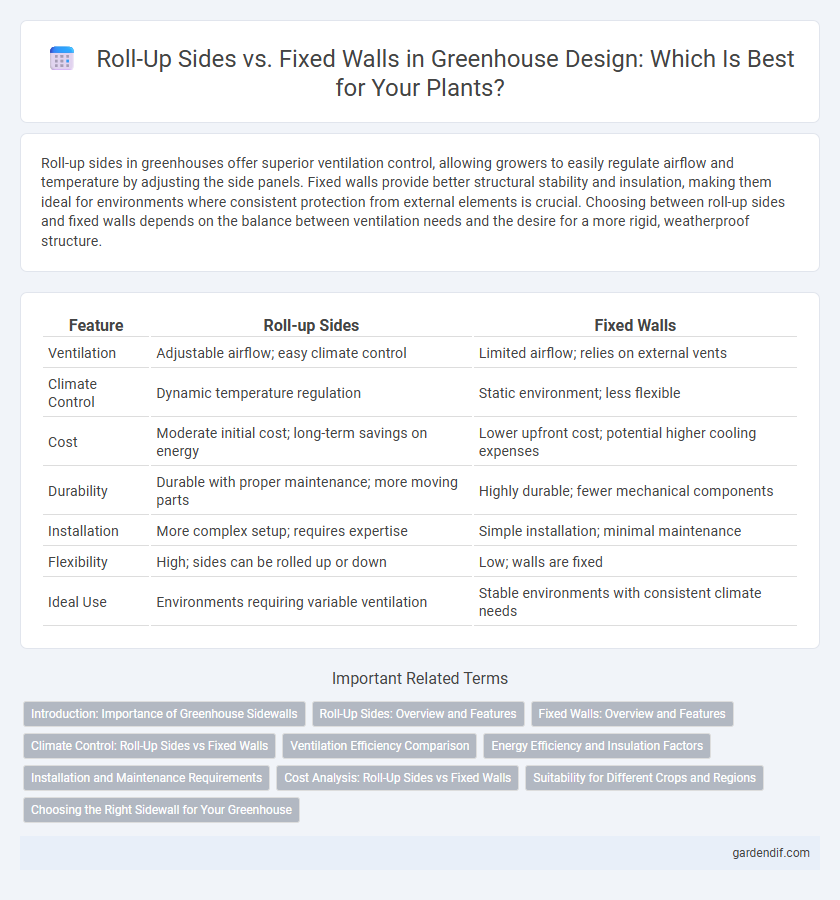
Roll-up sides vs fixed walls Illustration
Roll-up sides in greenhouses offer superior ventilation control, allowing growers to easily regulate airflow and temperature by adjusting the side panels. Fixed walls provide better structural stability and insulation, making them ideal for environments where consistent protection from external elements is crucial. Choosing between roll-up sides and fixed walls depends on the balance between ventilation needs and the desire for a more rigid, weatherproof structure.
Table of Comparison
| Feature | Roll-up Sides | Fixed Walls |
|---|---|---|
| Ventilation | Adjustable airflow; easy climate control | Limited airflow; relies on external vents |
| Climate Control | Dynamic temperature regulation | Static environment; less flexible |
| Cost | Moderate initial cost; long-term savings on energy | Lower upfront cost; potential higher cooling expenses |
| Durability | Durable with proper maintenance; more moving parts | Highly durable; fewer mechanical components |
| Installation | More complex setup; requires expertise | Simple installation; minimal maintenance |
| Flexibility | High; sides can be rolled up or down | Low; walls are fixed |
| Ideal Use | Environments requiring variable ventilation | Stable environments with consistent climate needs |
Introduction: Importance of Greenhouse Sidewalls
Greenhouse sidewalls play a crucial role in regulating temperature, ventilation, and humidity levels, directly impacting plant growth and crop yield. Roll-up sides offer adjustable airflow control, enabling quick ventilation adjustments based on weather conditions, while fixed walls provide durable insulation and protection from pests and extreme weather. Choosing the right sidewall type enhances climate management and energy efficiency, essential factors for optimizing greenhouse productivity.
Roll-Up Sides: Overview and Features
Roll-up sides in greenhouses provide adjustable ventilation, allowing precise control over temperature and humidity levels essential for optimal plant growth. These sides can be easily raised or lowered to enhance airflow, reduce heat buildup, and prevent mold or mildew, making them ideal for varying weather conditions. Unlike fixed walls, roll-up sides improve energy efficiency and extend the growing season by enabling customizable environmental control.
Fixed Walls: Overview and Features
Fixed walls in a greenhouse provide enhanced structural stability and superior insulation compared to roll-up sides, making them ideal for maintaining consistent internal temperatures. Constructed from durable materials such as polycarbonate panels or glass, fixed walls improve light diffusion while minimizing heat loss and exposure to external elements. This design feature supports year-round plant growth by creating a controlled environment resistant to wind and pests.
Climate Control: Roll-Up Sides vs Fixed Walls
Roll-up sides in greenhouses provide dynamic climate control by enabling increased ventilation and rapid temperature adjustments, ideal for preventing overheating and maintaining optimal humidity levels. Fixed walls offer more stable insulation, creating consistent internal temperatures essential for protecting plants during extreme weather or colder seasons. Choosing between roll-up sides and fixed walls depends on the crop requirements and the need for flexible air circulation versus thermal stability.
Ventilation Efficiency Comparison
Roll-up sides in greenhouses significantly enhance ventilation efficiency by allowing adjustable airflow based on weather conditions, which prevents overheating and promotes consistent temperature control. Fixed walls provide limited ventilation options, often relying on roof vents that may not sufficiently regulate humidity or temperature during peak heat. Optimized airflow from roll-up sides reduces the risk of plant stress and improves overall crop yield by facilitating better gas exchange and moisture management.
Energy Efficiency and Insulation Factors
Roll-up sides in greenhouses offer adjustable ventilation, enhancing air circulation and reducing the need for mechanical cooling, which promotes energy efficiency during warmer months. Fixed walls provide superior insulation by minimizing heat loss and maintaining more consistent internal temperatures, crucial for energy conservation in colder climates. Choosing between roll-up sides and fixed walls depends on balancing the need for ventilation control against the priority for thermal retention to optimize energy use.
Installation and Maintenance Requirements
Roll-up sides offer easier installation as they typically require fewer tools and less structural modification compared to fixed walls, making setup quicker and less labor-intensive. Maintenance of roll-up sides is generally simpler due to their modular design, allowing for easier repairs and replacement of damaged panels without dismantling large sections of the greenhouse. Fixed walls, while more durable, often demand more extensive installation processes and higher maintenance efforts to address potential structural issues and weather sealing over time.
Cost Analysis: Roll-Up Sides vs Fixed Walls
Roll-up sides typically reduce initial construction costs compared to fixed walls due to simpler framing and materials, enhancing ventilation and lowering cooling expenses. Fixed walls often require more durable materials and additional insulation, driving up installation and maintenance costs but providing superior climate control. Evaluating long-term energy savings and durability is essential for accurate cost analysis between roll-up sides and fixed wall greenhouses.
Suitability for Different Crops and Regions
Roll-up sides in greenhouses provide adjustable ventilation, making them ideal for crops requiring precise temperature and humidity control, such as tomatoes and peppers, especially in regions with fluctuating climates. Fixed walls offer better insulation, suited for cold-resistant crops like lettuce and herbs in colder regions where maintaining stable internal temperatures is crucial. Choosing between roll-up sides and fixed walls depends on crop sensitivity and local weather patterns to optimize growth conditions.
Choosing the Right Sidewall for Your Greenhouse
When selecting sidewalls for your greenhouse, roll-up sides offer superior ventilation control by allowing adjustable airflow based on temperature and humidity levels, enhancing plant health and reducing heat buildup. Fixed walls provide better insulation and structural stability, ideal for colder climates or permanent setups requiring consistent internal conditions. Consider your local climate, crop type, and ventilation needs to determine whether roll-up sides or fixed walls will optimize your greenhouse environment.
Roll-up sides vs fixed walls Infographic

 gardendif.com
gardendif.com